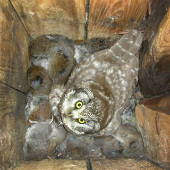Extinction Threatens the Boreal Owl
Half a century ago, the Boreal owl was the most numerous predatory bird in Eurasian boreal forests. However, during the last twenty years the Boreal owl population has diminished noticeably. This is because of the vanishing old-growth boreal forests, explains the new book by researchers of the University of Turku.
 At the moment, the owl population decreases annually by two per cent. The worst case scenario is that this leads to the Boreal owls’extinction in 30 years’ time. The information is presented in the new book by the Professor Erkki Korpimäki from the Ecology Department of the University of Turku and Docent Harri Hakkarainen. The book called The Boreal Owl concentrates on the ecology, behaviour and conservation of the Boreal owl. It is published by the prestigious Cambridge University Press.
At the moment, the owl population decreases annually by two per cent. The worst case scenario is that this leads to the Boreal owls’extinction in 30 years’ time. The information is presented in the new book by the Professor Erkki Korpimäki from the Ecology Department of the University of Turku and Docent Harri Hakkarainen. The book called The Boreal Owl concentrates on the ecology, behaviour and conservation of the Boreal owl. It is published by the prestigious Cambridge University Press.
The decreasing of the Boreal owl population and the reasons for it, are based on long term research knowledge which has been collected for over 40 years in Southern Ostrobothnia in an area of over 1000 square kilometers. In addition, bird-watchers and ringers all over Finland have collected data from almost all areas covered by local bird clubs.
The Boreal owl is in fact the first vertebrate species which has helped to prove that the individual’s survival and lifetime reproductive success are the greater the more the habitat has old-growth or middle aged forests. Old forests offer more hiding places from larger birds of prey, like the Ural owl and the Northern goshawk, and they also offer more food, especially during the winter. However, climate change seems to have no noticeable effect on the Boreal owl population’s reproductive success.
Lifetime’s Work in a Book
Translation: SM
Photograph: EK and HH